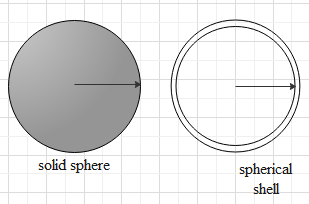
Two spheres of equal masses, one of which is a thin spherical shell and the other a solid, have the same moment of inertia about their respective diameters. The ratio of their radii well be.
$\begin{align}
& \text{A}.\text{ }5:7 \\
& \text{B}.\text{ }3:5 \\
& \text{C}.\text{ }\sqrt{3:}\sqrt{5} \\
& \text{D}.\text{ }\sqrt{3:}\sqrt{7} \\
\end{align}$
Answer
483.6k+ views
Hint: We have to find a ratio of thin spherical shell and a solid shell. So first we will find the moment of inertia of both the shells and it is given that the moment of inertia in both cases are the same so we will equate the equations and further solve to find their ratios.
Complete answer:

Moment of inertia of thin spherical shell is given by
${{I}_{1}}=\dfrac{2}{3}MR_{1}^{2}$
Moment of inertia of thin spherical shell is given by
${{I}_{2}}=\dfrac{2}{5}MR_{2}^{2}$
As both the masses of spheres are the same let the mass be m.
Let the radii of the thin spherical shell be\[{{R}_{1}}\].
The radii of the thin spherical shell be${{R}_{2}}$.
Moment of inertia of thin spherical shell about the diameter is given by
${{I}_{1}}=\dfrac{2}{3}MR_{1}^{2}$
Moment of inertia of thin spherical shell about the diameter is given by
${{I}_{2}}=\dfrac{2}{5}MR_{2}^{2}$
As given in the question both the moment of inertia are same,
Hence equating both the moment of inertia we get
$\dfrac{2}{3}MR_{1}^{2}=\dfrac{2}{5}MR_{2}^{2}$
Both the masses are same therefore,
$\begin{align}
& \dfrac{2}{3}MR_{1}^{2}=\dfrac{2}{5}MR_{2}^{2} \\
& \dfrac{R_{1}^{2}}{R_{2}^{2}}=\dfrac{3}{5} \\
& {{\left( \dfrac{{{R}_{1}}}{{{R}_{2}}} \right)}^{2}}=\dfrac{3}{5} \\
& \dfrac{{{R}_{1}}}{{{R}_{2}}}=\dfrac{\sqrt{3}}{\sqrt{5}} \\
\end{align}$
So the ratio obtained is $\sqrt{3:}\sqrt{5}$.
So, the correct answer is “Option C”.
Additional Information:
Physical significance of moment of inertia is the mass of a body that resists a change in its state of linear motion, it is a measure of its inertia in a linear motion.
Note:
Moment of inertia about the rigid body about a fixed axis is defined as the sum of the product of the masses of the particles constituting the body and the squares of their respective axis from the axis of rotation.
$I=\sum\limits_{i=1}^{n}{{{m}_{i}}r_{i}^{2}}$
We use the above expression to calculate the moment of inertia.
Solid sphere and spherical shell have the same radius if they are of the same volume. The difference between both is just that spherical shell is hollow from the inside.
Complete answer:

Moment of inertia of thin spherical shell is given by
${{I}_{1}}=\dfrac{2}{3}MR_{1}^{2}$
Moment of inertia of thin spherical shell is given by
${{I}_{2}}=\dfrac{2}{5}MR_{2}^{2}$
As both the masses of spheres are the same let the mass be m.
Let the radii of the thin spherical shell be\[{{R}_{1}}\].
The radii of the thin spherical shell be${{R}_{2}}$.
Moment of inertia of thin spherical shell about the diameter is given by
${{I}_{1}}=\dfrac{2}{3}MR_{1}^{2}$
Moment of inertia of thin spherical shell about the diameter is given by
${{I}_{2}}=\dfrac{2}{5}MR_{2}^{2}$
As given in the question both the moment of inertia are same,
Hence equating both the moment of inertia we get
$\dfrac{2}{3}MR_{1}^{2}=\dfrac{2}{5}MR_{2}^{2}$
Both the masses are same therefore,
$\begin{align}
& \dfrac{2}{3}MR_{1}^{2}=\dfrac{2}{5}MR_{2}^{2} \\
& \dfrac{R_{1}^{2}}{R_{2}^{2}}=\dfrac{3}{5} \\
& {{\left( \dfrac{{{R}_{1}}}{{{R}_{2}}} \right)}^{2}}=\dfrac{3}{5} \\
& \dfrac{{{R}_{1}}}{{{R}_{2}}}=\dfrac{\sqrt{3}}{\sqrt{5}} \\
\end{align}$
So the ratio obtained is $\sqrt{3:}\sqrt{5}$.
So, the correct answer is “Option C”.
Additional Information:
Physical significance of moment of inertia is the mass of a body that resists a change in its state of linear motion, it is a measure of its inertia in a linear motion.
Note:
Moment of inertia about the rigid body about a fixed axis is defined as the sum of the product of the masses of the particles constituting the body and the squares of their respective axis from the axis of rotation.
$I=\sum\limits_{i=1}^{n}{{{m}_{i}}r_{i}^{2}}$
We use the above expression to calculate the moment of inertia.
Solid sphere and spherical shell have the same radius if they are of the same volume. The difference between both is just that spherical shell is hollow from the inside.
Recently Updated Pages
Glucose when reduced with HI and red Phosphorus gives class 11 chemistry CBSE

The highest possible oxidation states of Uranium and class 11 chemistry CBSE

Find the value of x if the mode of the following data class 11 maths CBSE

Which of the following can be used in the Friedel Crafts class 11 chemistry CBSE

A sphere of mass 40 kg is attracted by a second sphere class 11 physics CBSE

Statement I Reactivity of aluminium decreases when class 11 chemistry CBSE

Trending doubts
10 examples of friction in our daily life

One Metric ton is equal to kg A 10000 B 1000 C 100 class 11 physics CBSE

Difference Between Prokaryotic Cells and Eukaryotic Cells

State and prove Bernoullis theorem class 11 physics CBSE

What organs are located on the left side of your body class 11 biology CBSE

How many valence electrons does nitrogen have class 11 chemistry CBSE




